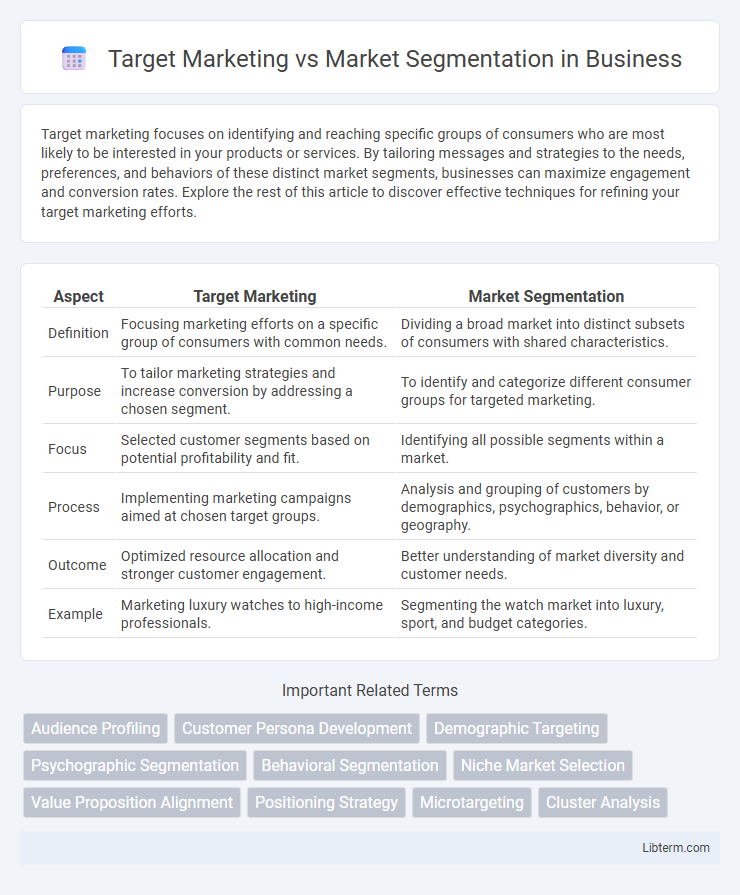Target marketing focuses on identifying and reaching specific groups of consumers who are most likely to be interested in your products or services. By tailoring messages and strategies to the needs, preferences, and behaviors of these distinct market segments, businesses can maximize engagement and conversion rates. Explore the rest of this article to discover effective techniques for refining your target marketing efforts.
Table of Comparison
| Aspect | Target Marketing | Market Segmentation |
|---|---|---|
| Definition | Focusing marketing efforts on a specific group of consumers with common needs. | Dividing a broad market into distinct subsets of consumers with shared characteristics. |
| Purpose | To tailor marketing strategies and increase conversion by addressing a chosen segment. | To identify and categorize different consumer groups for targeted marketing. |
| Focus | Selected customer segments based on potential profitability and fit. | Identifying all possible segments within a market. |
| Process | Implementing marketing campaigns aimed at chosen target groups. | Analysis and grouping of customers by demographics, psychographics, behavior, or geography. |
| Outcome | Optimized resource allocation and stronger customer engagement. | Better understanding of market diversity and customer needs. |
| Example | Marketing luxury watches to high-income professionals. | Segmenting the watch market into luxury, sport, and budget categories. |
Understanding Target Marketing
Target marketing involves identifying and focusing on specific groups of consumers within a broader market to tailor marketing efforts effectively. It uses demographic, psychographic, and behavioral data to create customized campaigns that maximize engagement and conversion rates. Understanding target marketing enables businesses to allocate resources efficiently, enhance customer satisfaction, and increase return on investment by addressing the unique needs of defined market segments.
Defining Market Segmentation
Market segmentation involves dividing a broad consumer or business market into sub-groups based on shared characteristics such as demographics, psychographics, geographic location, or behavioral patterns. This process allows businesses to identify specific segments with unique needs and preferences, enabling more tailored marketing strategies. Unlike target marketing, which concentrates on selecting one or more of these segments to serve, market segmentation establishes the foundational framework for understanding and categorizing customers.
Key Differences Between Target Marketing and Market Segmentation
Target marketing involves selecting specific groups within a market to direct marketing efforts toward, while market segmentation is the process of dividing the entire market into distinct subsets based on characteristics like demographics, psychographics, or behavior. Market segmentation identifies potential customer clusters, whereas target marketing focuses on choosing the most profitable or relevant segments to engage. The key difference lies in segmentation being a data-driven analysis phase and target marketing being the strategic application of that analysis for tailored marketing campaigns.
Importance of Target Marketing in Business Strategy
Target marketing is crucial in business strategy as it enables companies to concentrate resources on specific customer groups most likely to purchase their products, increasing marketing efficiency and return on investment. Market segmentation divides a broad audience into distinct segments based on demographics, behavior, or needs, but target marketing applies this segmentation to develop tailored marketing campaigns. Prioritizing target marketing helps businesses achieve higher customer engagement, brand loyalty, and competitive advantage by addressing the unique preferences of each segment.
Benefits of Effective Market Segmentation
Effective market segmentation enables businesses to identify distinct customer groups, allowing for tailored marketing strategies that increase engagement and conversion rates. By focusing resources on specific segments, companies improve product development efficiency and customer satisfaction. This precision leads to higher return on investment (ROI) and competitive advantage in target marketing efforts.
Steps in Developing a Market Segmentation Strategy
Developing a market segmentation strategy involves identifying distinct customer groups based on demographics, psychographics, geographic location, and behavioral patterns to tailor marketing efforts effectively. Target marketing follows by selecting the most viable segments that align with the company's strengths and market potential, optimizing resource allocation for maximum ROI. Key steps include market research, segment identification, evaluation of segment attractiveness, selection of target segments, and designing customized marketing mixes.
Techniques for Identifying Target Markets
Target marketing techniques include analyzing demographic data, psychographic profiles, and behavioral patterns to pinpoint consumers most likely to purchase products or services. Market segmentation involves dividing a broad consumer or business market into smaller groups based on criteria such as age, income, lifestyle, or buying habits to tailor marketing strategies effectively. Utilizing data analytics, surveys, and customer feedback helps marketers identify profitable segments and customize messaging for enhanced engagement and conversion rates.
Real-world Examples of Target Marketing and Market Segmentation
Target marketing involves directing advertising efforts toward specific consumer groups identified by shared characteristics, such as Nike targeting athletes with performance gear. Market segmentation divides a broad consumer market into sub-groups like age, income, or lifestyle, exemplified by Coca-Cola offering different beverages for health-conscious, youth, and premium segments. Companies like Amazon use both strategies by segmenting users based on purchasing behavior and then targeting personalized product recommendations.
Common Mistakes to Avoid in Target Marketing and Segmentation
Common mistakes in target marketing and market segmentation include overlooking detailed customer data and relying on overly broad segments, which can result in ineffective campaigns and wasted resources. Businesses often confuse demographic factors with psychographic insights, neglecting behavioral patterns that drive purchasing decisions. Ignoring the dynamic nature of markets by failing to regularly update segments and target strategies leads to outdated marketing efforts and lost competitive advantage.
Choosing the Right Approach for Your Business
Selecting the right approach between target marketing and market segmentation depends on your business goals and customer insights. Market segmentation divides a broad consumer base into distinct groups based on demographics, behaviors, or needs, enabling tailored marketing strategies. Target marketing then focuses on specific segments with customized messages to maximize engagement and return on investment.
Target Marketing Infographic

 libterm.com
libterm.com